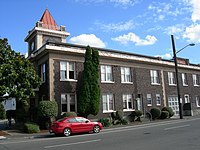
Renton is a city in King County, Washington, and an inner-ring suburb of Seattle. Situated 11 miles (18 km) southeast of downtown Seattle, Renton straddles the southeast shore of Lake Washington, at the mouth of the Cedar River. As of the 2020 census, the population of Renton was 106,785, up from 90,927 at the 2010 census. The city is currently the sixth-largest municipality in greater Seattle and the ninth-largest in Washington state.

Tukwila is a suburban city in King County, Washington, United States, located immediately to the south of Seattle. The population was 21,798 at the 2020 census.

The Duwamish River is the name of the lower 12 miles (19 km) of Washington state's Green River. Its industrialized estuary is known as the Duwamish Waterway. In 2009, the Duwamish Longhouse and Cultural Center was opened on the west bank of the river as part of the tribe's reassertion of its historic rights in the area and its continuing struggle for federal recognition of tribal status.

This is the main article of a series that covers the history of Seattle, Washington, a city in the Pacific Northwest region of the United States of America.
History of Seattle, Washington 1900–1940
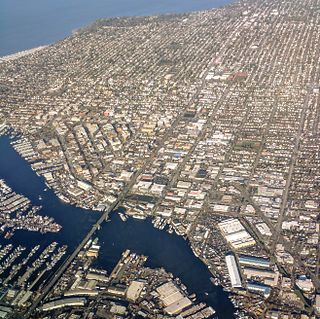
Ballard is a neighborhood in the northwestern area of Seattle, Washington, United States. Formerly an independent city, the City of Seattle's official boundaries define it as bounded to the north by Crown Hill, to the east by Greenwood, Phinney Ridge and Fremont, to the south by the Lake Washington Ship Canal, and to the west by Puget Sound's Shilshole Bay. Other neighborhood or district boundaries existed in the past; these are recognized by various Seattle City Departments, commercial or social organizations, and other Federal, State, and local government agencies.

Foggy Bottom is one of the oldest late 18th- and 19th-century neighborhoods in Washington, D.C., located west of the White House and downtown Washington, in the Northwest quadrant. It is bounded roughly by 17th Street NW to the east, Rock Creek Parkway to the west, Constitution Avenue NW to the south, and Pennsylvania Avenue NW to the north.

The Rainier Brewing Company was an American brewery based in Seattle, Washington. It brewed Rainier Beer, a popular brand in the Pacific Northwest of the United States. Although Rainier was founded in 1884, the Seattle site had been brewing beer since 1878. The beer is no longer brewed in Seattle, nor is the company owned locally. In the late 1990s, the company was sold to Stroh's, then to Pabst Brewing Company, though Miller contract brews most of Pabst's beers. The brewery was closed by Pabst in 1999 and sold.
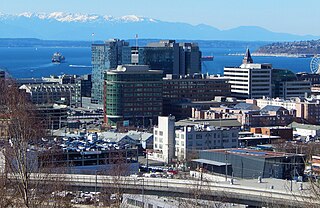
SoDo, alternatively SODO, is a neighborhood in Seattle, Washington, that makes up part of the city's Industrial District. It is bounded on the north by South King Street, beyond which is Pioneer Square; on the south by South Spokane Street, beyond which is more of the Industrial District; on the west by the Duwamish River, across which is West Seattle; and on the east by Metro Transit's Downtown Seattle Transit Tunnel and SoDo Busway, beyond which is the International District and the rest of the Industrial District.

The Industrial District is the principal industrial area of Seattle, Washington. It is bounded on the west by the Duwamish River and Elliott Bay, beyond which lies Delridge of West Seattle; on the east by Interstate 5, beyond which lies Beacon Hill; on the north by S King and S Dearborn Streets, beyond which lie Pioneer Square and southwest International District of Downtown; and on the south by the main lines of the BNSF Railway and Union Pacific Railroad, or about S Lucille Street, beyond which is Georgetown. SoDo is the name of the northwest portion of the neighborhood, named for its being South of Downtown. SoDo is the location of T-Mobile Park, home of the Seattle Mariners, and Lumen Field, home of the Seattle Seahawks and Seattle Sounders FC. Lumen Field was also the site of the former Kingdome.

Beacon Hill is a hill and neighborhood in southeast Seattle, Washington. It is roughly bounded on the west by Interstate 5, on the north by Interstate 90, on the east by Rainier Avenue South, Cheasty Boulevard South, and Martin Luther King Junior Way South, and on the south by the Seattle city boundary. It is part of Seattle's South End.

Delridge is a district in West Seattle, Washington, United States that stretches along Delridge Way, an arterial that follows the eastern slope of the valley of Longfellow Creek, from near its source just within the southern city limits north to the West Seattle Bridge over the Duwamish River.

Brewerytown is a neighborhood in the North Philadelphia section of Philadelphia, Pennsylvania, United States. An unofficial region, Brewerytown runs approximately between the Schuylkill River's eastern bank and 25th Street, bounded by Cecil B. Moore Avenue to the north and Parrish Street to the south. Brewerytown got its name because of the numerous breweries that were located along the Schuylkill during the late 19th century and early 20th century. It is now primarily a residential neighborhood, with a growing and active commercial sector along Girard Avenue.

South Park is a neighborhood in Seattle, Washington. It is located just south of Georgetown across the Duwamish River, and just north of the city of Tukwila. Its main thoroughfares are West Marginal Way S., S. Cloverdale Street and 14th Ave. S (north-and-south). South Park connects to Georgetown by two bridges at 1st Ave S. at the northmost end of the neighborhood, and the South Park Bridge at the north end of 14th Ave. South. The South Park Bridge was closed on June 30, 2010, and reconstructed due to safety concerns. The newly constructed bridge reopened to traffic on June 30, 2014.

The Christian Heurich Brewing Company was a Washington, D.C., brewery founded in 1872 and incorporated by Christian Heurich in 1890. First located near Dupont Circle on 20th Street NW, it expanded to a much larger site in Foggy Bottom in 1895 after a major fire. The new brewery was located along the Potomac River at 26th Street and D Street NW, where the John F. Kennedy Center for the Performing Arts now stands. The Heurich brewery was the largest in Washington's history, capable of producing 500,000 barrels of beer a year and 250 tons of ice daily.
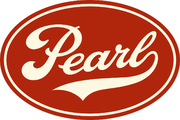
The Pearl Brewing Company was an American brewery established in 1883 in Downtown San Antonio, Texas, United States. In 1985, Pearl's parent company purchased the Pabst Brewing Company and assumed the Pabst name.
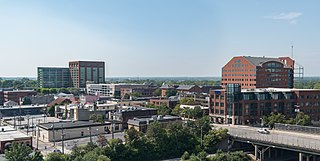
The Brewery District, traditionally known as the Old German Brewing District, is a neighborhood located in Columbus, Ohio. Located just south of the central business district and west of German Village, it is bounded by Interstate 70 on the north, South Pearl Street on the east, Greenlawn Avenue on the south, and the Scioto River on the west.

The history of Olympia, Washington, includes long-term habitation by Native Americans, charting by a famous English explorer, settlement of the town in the 1840s, the controversial siting of a state college in the 1960s and the ongoing development of arts and culture from a variety of influences.

Kips Bay Brewing Company, also known as Kips Bay Brewing and Malting Co. and Patrick Skelly Brewery, was a brewery located in Manhattan, New York City that operated from 1894 to 1947. The former company's buildings have been repurposed into offices and are one of two groups of surviving brewery structures in Manhattan from the period when brewing was a major industry in the city.




